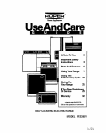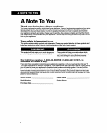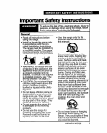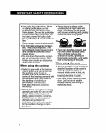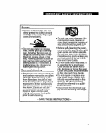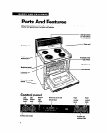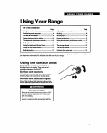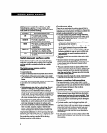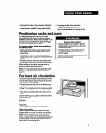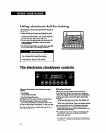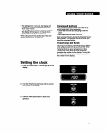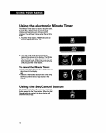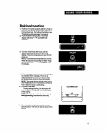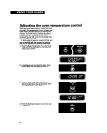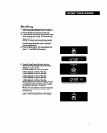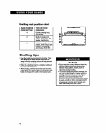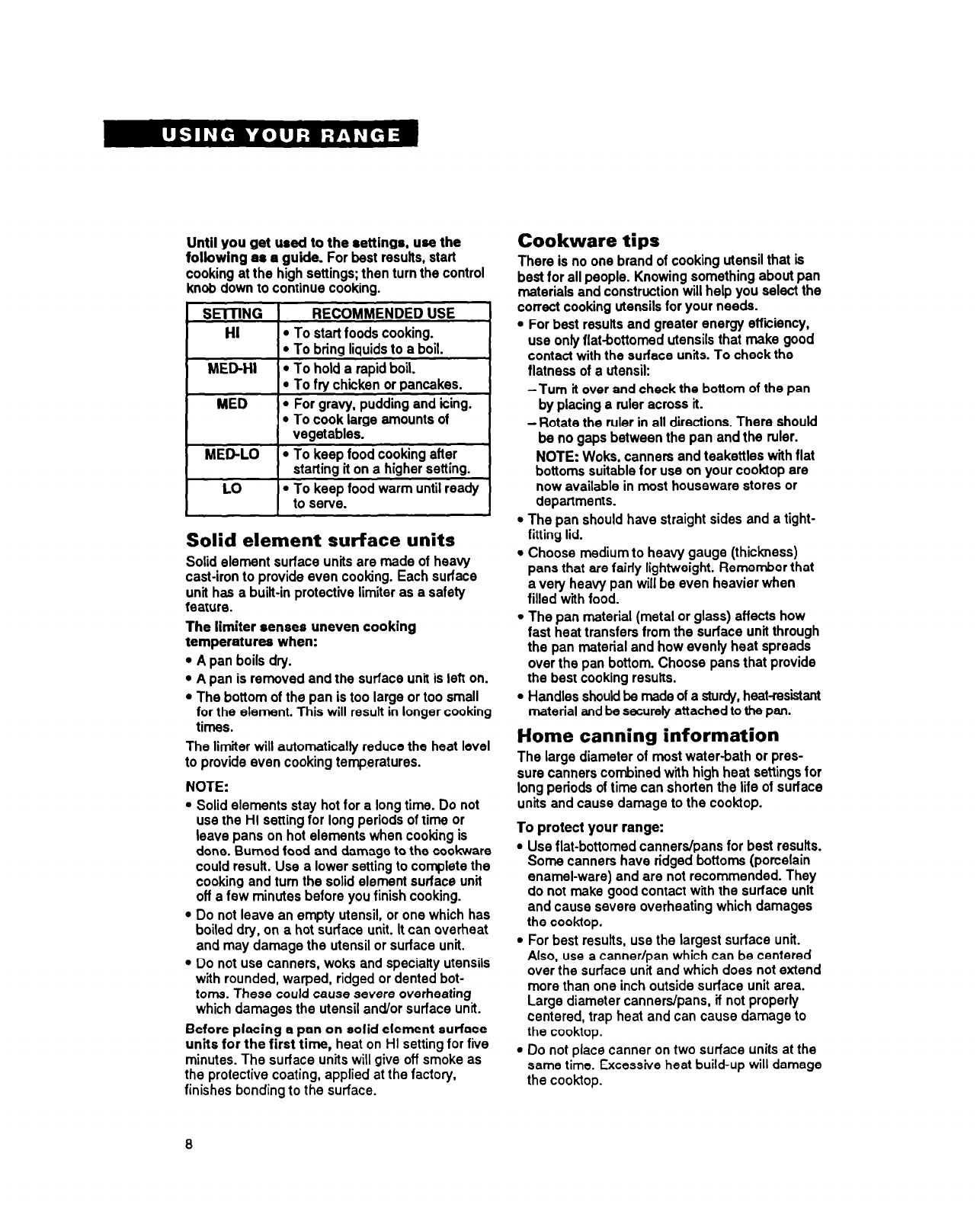
Until you get used to the settings, use the
following as a guide. For best results, start
cooking at the high settings; then turn the control
knob down to continue cooking.
Sl3llNG
RECOMMENDED USE
HI
l
To start foods cooking.
l
To bring liquids to a boil.
MEDHI
l
To hold a rapid boil.
l
To fry chicken or pancakes.
MED
l
For gravy, pudding and icing.
l
To cook large amounts of
vegetables.
MED-LO
l
To keep food cooking after
starting it on a higher setting.
LO
l
To keep food warm until ready
I
to serve.
I
Solid element surface units
Solid element surface units are made of heavy
cast-iron to provide even cooking. Each surface
unit has a built-in protective limiter as a safety
feature.
The limiter senses uneven cooking
temperatures when:
l
A pan boils dry.
l
A pan is removed and the surface unit is left on.
l
The bottom of the pan is too large or too small
for the element. This will result in longer cooking
times.
The limiter will automatically reduce the heat level
to provide even cooking temperatures.
NOTE:
l
Solid elements stay hot for a long time. Do not
use the HI setting for long periods of time or
leave pans on hot elements when cooking is
done. Burned food and damage to the cookware
could result. Use a lower setting to complete the
cooking and turn the solid element surface unit
off a few minutes before you finish cooking.
l
Do not leave an empty utensil, or one which has
boiled dry, on a hot surface unit. It can overheat
and may damage the utensil or surface unit.
l
Do not use canners, woks and speciatly utensils
with rounded, warped, ridged or dented bot-
toms. These could cause severe overheating
which damages the utensil andlor surface unit.
Before placing a pan on solid element surface
units for the first time, heat on HI setting for five
minutes. The surface units will give off smoke as
the protective coating, applied at the factory,
finishes bonding to the surface.
Cookware tips
There is no one brand of cooking utensil that is
best for all people. Knowing something about pan
materials and construction will help you select the
correct cooking utensils for your needs.
l
For best results and greater energy efficiency,
use only flat-bottomed utensils that make good
contact with the surface units. To check the
flatness of a utensil:
-Turn it over and check the bottom of the pan
by placing a ruler across it.
-Rotate the ruler in all directions. There should
be no gaps between the pan and the ruler.
NOTE: Woks, canners and teakettles with flat
bottoms suitable for use on your cooktop are
now available in most houseware stores or
departments.
l
The pan should have straight sides and a tight-
fitting lid.
l
Choose medium to heavy gauge (thickness)
pans that are fairly lightweight. Remember that
a very heavy pan will be even heavier when
filled with food.
l
The pan material (metal or glass) affects how
fast heat transfers from the surface unit through
the pan material and how evenly heat spreads
over the pan bottom. Choose pans that provide
the best cooking results.
l
Handles should be made of a sturdy, heat-resistant
material and be securely attached to the pan.
Home canning information
The large diameter of most water-bath or pres-
sure canners combined with high heat settings for
long periods of time can shorten the life of surface
units and cause damage to the cooktop.
To protect your range:
l
Use flat-bottomed canners/pans for best results.
Some canners have ridged bottoms (porcelain
enamel-ware) and are not recommended. They
do not make good contact with the surface unit
and cause severe overheating which damages
the cook-top.
l
For best results, use the largest surface unit.
Also, use a canner/pan which can be centered
over the surface unit and which does not extend
more than one inch outside surface unit area.
Large diameter canners/pans, if not properly
centered, trap heat and can cause damage to
the cooktop.
l
Do not place canner on two surface units at the
same time. Excessive heat build-up will damage
the cooktop.
El



